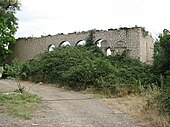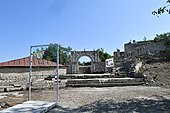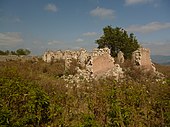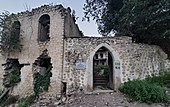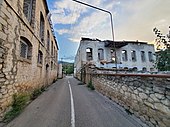User:Grandmaster/Shusha destruction
Text sources[edit]
Chapter:
Language Removal, Commodification and the Negotiation of Cultural Identity in Nagorno-Karabakh
Pages 77-100
by Muth, Sebastian
In the past century, Shusha was destroyed three times, for the first time in 1905 in the Armenian-Tartar War, when interethnic violence between Armenians and Azerbaijanis left the city in ruins. Right before Karabakh became part of the Soviet Union, Azerbaijani forces destroyed the Armenian quarters of the city in 1920. Virtually the whole ethnic-Armenian population of the city perished or was exiled in what later became known as the Shusha pogrom (De Waal, 2003, pp. 52-53). For the third time the city was destroyed by Armenians in 1992 during the Nagorno-Karabakh War, when Armenian militias conquered one of the last Azerbaijani strongholds in Karabakh in a victory that is commemorated annually throughout the Nagorno-Karabakh Republic on May 9. Following previous patterns, this time the Azerbaijani quarter of Shusha was looted and its cultural monuments defaced or destroyed.
Given the troubled history of Sbusha, the city and its landscape frame and embody historic, cultural and political processes (cf. Czepczynski, 2008, p. 47) for both Armenians and Azerbaijanis. However, today Shusha is a largely depopulated town that is slowly being resettled by ethnic Armenians. Azerbaijani religious monuments of historic significance such as the Ashaghi Govhar Agha Mosque (Figure 4.2) were either destroyed or are left in disrepair, while the whole of the former Azerbaijani quarter is abandoned. Similar to the effects of the pogrom of 1920 when the ruins of the Armenian quarter were left standing until removed by Soviet-Azerbaijani urban planning in 1961 (De Waal, 2003, p. 52), the Azerbaijani quarter of Shusha remains as a reminder of defeat. Inside the quarter, remnants of the former inhabitants and their language, culture and architecture are visible in the form of old noticeboards written in Azeri in Cyrillic script or ornamental verses in Arabic and Persian on the walls of mosques (cf. Muth, 2014, pp. 73-75). Local Armenian informants highlighted the former significance of particular architectural structures such as the former local headquarters of the Azerbaijani Ministry of Interior's security forces (Figure 4.3).
Small war, big mess; Nagorno-Karabakh. The Economist, 20 November 2004
Shusha, near Stepanakert, illustrates the problem. Once one of the most charming places in the Caucasus, it is now a ghost town of gutted buildings and overgrown graveyards. Its Azeri population is gone. Many inhabitants are Armenian refugees from Azerbaijan, living wretchedly in what remains of ransacked apartments.
Europe’s forgotten war. Maclean's, August 30 1993.
A few kilometres across the Azeri-Armenian border and up the twisting, pockmarked single-lane road to Nagorno-Karabakh, the formerly Azeri town of Lachin, after which the corridor is named, sits nestled among the steep inclines. As the town comes into closer view, it is clear that the destruction is absolute. No building, no home, no school, not a bus shelter has been left unscarred. In the doorway of one house, behind its overgrown front garden, a pair of shoes signals the former occupant's rush to flee an oncoming army.
......
Leaving Lachin, the road enters Nagorno-Karabakh itself. The route is barren and unspoiled except for the debris of past battles. Rusting, dismembered tanks and trucks dot the roadside to Shusha, the next big town, an hour's drive away. Once a prosperous textile manufacturing centre of 40,000 people, 90 per cent of them Azeri, Shusha has been reduced to rubble. Women carry pails of spring water through the broken streets. Children play on the heaps of crumbled apartment blocks. The all too familiar sights of burnt and shattered buildings and homes are everywhere. [1]
Thomas de Waal. Shusha Armenians recall their bittersweet victory. Institute for War and Peace Reporting, 10 May 2002
Armenians in the oldest town in Nagorny Karabakh remember how a decade ago their forces captured it from the Azerbaijanis - and then burned it.
After a battle that lasted less than 24 hours, the Azerbaijanis abandoned their last stronghold in Karabakh almost intact. However, Armenians came in and set the town on fire. Ten years on, at least 80 per cent of Shusha is still in ruins. [2]
Owen Vince. Urbicide in Nagorno-Karabakh. Failed Architecture, 28 October 2015
When captured on 9 May 1992 by Armenian forces, the Azeri population fled, while the city was looted and burned. Estimates suggest that, by 2002, 80% of the city still lay in ruins. [3]
Dmitry Avaliani. In the Ruins of Shusha. Institute for War and Peace Reporting, 28 September, 2007
A ruined town in Karabakh makes a Georgian reporter reflect on this conflict and his own.
A new modern road winds through the little houses that resemble ancient Roman ruins and the awful tall ruined apartment blocks with dozens of empty windows yawning open. In the old town, now almost completely destroyed, a sign remains in the Azeri language saying that this is Nizami Street. A crane stands next to one of the two mosques - evidently the local authorities are restoring it to demonstrate their tolerance. [4]
Note: English translation has a mistake, it says "Armenian" instead of "Roman". In the original Russian text, available here, it is "Roman".
Azerbaijan begins controversial renovation of Armenian church. Eurasianet, May 7, 2021
The church renovation thus parallels in some ways Armenians’ custody of the Islamic and Azerbaijani cultural sites on the same territory during the time that they controlled it, from the 1990s until last year. Armenians, with some fanfare, restored a mosque in Shusha in 2019, but they labeled it “Persian” over the objections of Azerbaijanis. In many more cases, though, Armenians simply neglected non-Armenian historic sites, wrote them out of the region’s history, and let them fall into ruin or allowed them to be plundered, a process that Azerbaijanis are now trying to reverse. [5]
Foreign Ministry Rejects Pashinyan’s Claim about Shushi’s Surrender. Asbarez, November 16, 2020
“Shushi is a desolate and grim city,” said Pashinyan. “If Shushi was so important to everyone, why was it left in that condition and not developed?” [6]
Jonathan Steele. "Eyewitness: Armenia's looters follow its troops into Azerbaijan - Tit-for-tat pillage of deserted Lachin succeeds a war that may not yet be over." The Guardian, 25 May 1992, p. 22.
As we left Shusha, a young soldier and his friends were standing in the street, laughing and taking pot-shots with a rifle at the crescent on top of one of the delicately tiled minarets on the town's abandoned Azeri mosque. A few bricks from the tower crashed on to the roof, but as we turned the corner the crescent was still in place.
Photo evidence of cultural heritage destruction[edit]
-
Ashaghi Govhar Agha Mosque
-
Mardinli Mosque
-
Saatli mosque
-
Chukhur mehelle mosque
-
Khoja Marjanli Mosque
-
House-museum of Uzeyir Hajibeyov
-
House-museum and bust of Bulbul
-
Khan's palace
-
Palace of poetess Natavan
-
Palace of poetess Natavan, another facade
-
House of artist Mir Mohsun Navvab
-
House of Jabbar Garyagdioglu


